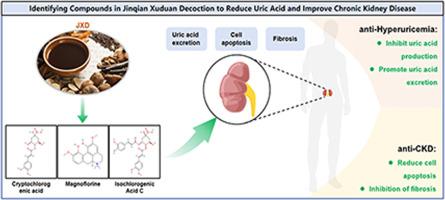Identifying the natural compounds in Jinqian Xuduan Decoction for simultaneous uric acid lowering and chronic kidney disease amelioration
IF 8.3
1区 医学
Q1 CHEMISTRY, MEDICINAL
引用次数: 0
Abstract
Introduction
Hyperuricemia (HUA) and chronic kidney disease (CKD) are prevalent metabolic disorders worldwide. Current therapeutic approaches have inherent limitations, making the exploration and development of natural medicines based on traditional Chinese medicine (EDNM-TCM) highly promising. Jinqian Xuduan decoction (JXD) is utilized for reducing uric acid and ameliorating CKD, but its underlying mechanism remains elusive, and no EDNM-TCM studies on it have hitherto been conducted.
Purpose
The primary aims of this study were to investigate the mechanism of JXD lowering uric acid and to identify natural lead compounds with multiple efficacies from JXD.
Methods
The mechanism of JXD in reducing uric acid was explored by employing a CKD mouse model induced by HUA. The active components within JXD that could concurrently lower uric acid and improve chronic kidney disease were screened and verified via integrative pharmacology, molecular docking, and molecular dynamics simulation. The effects of these components on reducing uric acid and improving chronic kidney disease were verified through both in vivo and in vitro experiments, and their mechanisms were preliminarily explored.
Results
JXD significantly reduces uric acid by inhibiting its production and enhancing excretion. It mitigates CKD by reducing renal cell apoptosis and fibrosis. Nine promising compounds were identified, among which three compounds—cryptochlorogenic acid, magnoflorine, and isochlorogenic acid C—significantly reduced uric acid levels in HUA mice by promoting excretion and alleviating CKD.
Conclusion
This study significantly expands the understanding of natural medicines based on traditional Chinese medicine in the treatment of HUA and CKD by thoroughly exploring the mechanisms of JXD. For the first time, it systematically screened and verified the key active components in JXD using integrative pharmacology, identifying three compounds with significant uric acid-lowering and anti-CKD effects—cryptochlorogenic acid, magnoflorine and isochlorogenic acid C. These findings not only enrich the scientific connotations of traditional Chinese medicine in the treatment of metabolic diseases but also provide important references for future research and clinical applications of new drugs.

金乾续端汤同时降尿酸和改善慢性肾脏病的天然化合物鉴定
高尿酸血症(HUA)和慢性肾病(CKD)是世界范围内普遍存在的代谢性疾病。目前的治疗方法存在固有的局限性,这使得基于中药的天然药物(EDNM-TCM)的探索和开发具有很大的前景。金乾续端汤具有降尿酸、改善CKD的作用,但其作用机制尚不明确,目前尚无EDNM-TCM对其的研究。目的探讨中药复方降尿酸的作用机制,并从中药复方中鉴定出具有多种药理作用的天然先导化合物。方法采用HUA致CKD小鼠模型,探讨健泻泻降尿酸的作用机制。通过结合药理学、分子对接、分子动力学模拟等方法筛选并验证JXD内具有降低尿酸和改善慢性肾脏病的活性成分。通过体内和体外实验验证了这些成分对降低尿酸和改善慢性肾脏疾病的作用,并初步探讨了其作用机制。结果jxd通过抑制尿酸的产生和促进尿酸的排出而显著降低尿酸水平。它通过减少肾细胞凋亡和纤维化来减轻CKD。9个有前景的化合物被鉴定出来,其中3个化合物——隐绿原酸、木兰花碱和异绿原酸c——通过促进排泄和缓解CKD显著降低HUA小鼠尿酸水平。结论本研究通过深入探索JXD的作用机制,显著拓展了以中药为基础的天然药物治疗HUA和CKD的认识。首次采用综合药理学方法系统筛选和验证了健脾散的关键活性成分,鉴定出具有显著降尿酸和抗ckd作用的3种化合物:隐绿原酸;这些发现不仅丰富了中医药治疗代谢性疾病的科学内涵,也为今后新药的研究和临床应用提供了重要参考。
本文章由计算机程序翻译,如有差异,请以英文原文为准。
求助全文
约1分钟内获得全文
求助全文
来源期刊

Phytomedicine
医学-药学
CiteScore
10.30
自引率
5.10%
发文量
670
审稿时长
91 days
期刊介绍:
Phytomedicine is a therapy-oriented journal that publishes innovative studies on the efficacy, safety, quality, and mechanisms of action of specified plant extracts, phytopharmaceuticals, and their isolated constituents. This includes clinical, pharmacological, pharmacokinetic, and toxicological studies of herbal medicinal products, preparations, and purified compounds with defined and consistent quality, ensuring reproducible pharmacological activity. Founded in 1994, Phytomedicine aims to focus and stimulate research in this field and establish internationally accepted scientific standards for pharmacological studies, proof of clinical efficacy, and safety of phytomedicines.
 求助内容:
求助内容: 应助结果提醒方式:
应助结果提醒方式:


